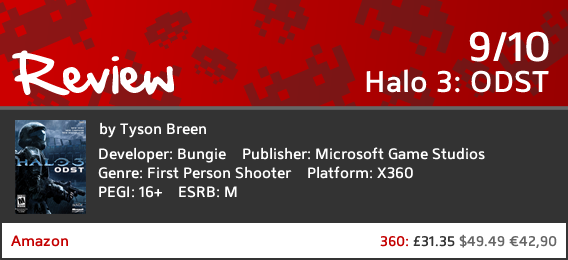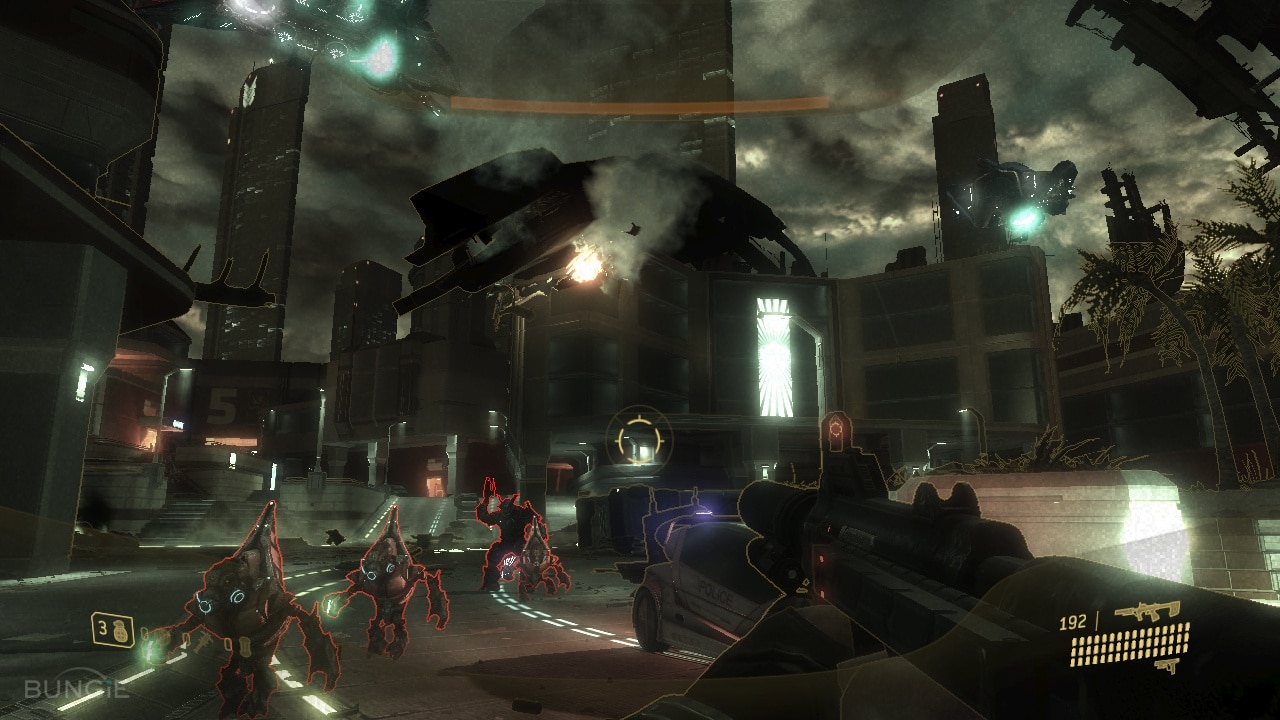
Latest news
Review: Halo 3: ODST
by Tyson Breen
 9.10.09
9.10.09
Ever since the release of Halo on the original Xbox, the Halo series has both set the bar and dominated the realm of console shooters. With the main story being wrapped up in 2007's Halo 3, series developed Bungie decided to created an offshoot to the franchise entitled Halo 3: ODST. Marketed as an extension to the Halo 3 experience, ODST puts the player in control of an Orbital Drop Shock Trooper (ODST) instead of the usual super soldier, Master Chief. When ODST was announced, it was first determined to be a straight up expansion to Halo 3, but through the course of its development, it has evolved into a full on retail package with its own multiplayer modes and campaign. However, the question is whether or not Bungie was once again successful in pleasing their die-hard fan base, or if they should have left the series with the closure it had.
ODST takes place during the events of Halo 2 and the beginning of Halo 3, in the Earth city of New Mombasa. The game kicks off with you taking the role of the rookie of an ODST squadron, barrelling toward the Earth in a pod with the rest of your squadron - hence "Orbital Drop". Upon impact though you are knocked unconscious for 6 hours and awake to find that it is already nightfall and the rest of your squad is nowhere to be found. You then take it upon yourself to find out what happened to the rest of the squad by exploring the open world streets of New Mombasa. By following waypoints marked on your minimap, you find objects such as a helmet and broken sniper rifle. These objects act as the start of a mission and once you find one, you are put into the shoes of one of your squad mates in a flashback scene. These flashbacks uncover story elements to help solve the mystery of what happened while you were asleep. The story in ODST is nothing special, but it is a series highpoint. The constant unravelling of story elements is incentive to keep players entrenched, and the flashback scenarios ensure that the levels are always varied from the last.

ODST is also a gorgeous game. Although it uses the same engine as Halo 3, a lot has been refined. The weapons have a shine that wasn't present before. Also, the character and enemy models look great. The biggest change in the graphics occurs in the environments however. From lush African wildlife settings, to claustrophobic cities,the world of ODST is breathtaking. The night-time environments also allow for the use of one of the games new features, the VISR. Short for Visual Intelligence System Reconnaissance, the VISR allows players to see in the dark. In addition to simple night vision, the VISR allows highlights important things in the environments; enemies in red, teammates in green, and clues in yellow. It's a helpful tool for dark fights, but brightness is increased which turns the screen almost entirely white if the VISR is used during the day.

Halo 3: ODST also comes packed with a second disc. Dubbed the multiplayer disc, it included the full multiplayer experience of Halo 3, including every downloadable map free of charge. This is one of the best multiplayer shooter games available to Xbox 360 owners, but many gamers will already own it if they were Halo fans to begin with. The extra maps are a good incentive to pick up the multiplayer again if you have been away from Halo for a while. Although it is a great competitive experience, the multiplayer disc feels like a last minute attempt to justify a full price on the package.


Labels: Bungie, Halo ODST, Microsoft, Review, Tyson, Tyson Breen
- Tyson Breen
Discuss this article in our friendly forums
Sign up to our community today and discuss our articles, debate over upcoming games and organise matches and playsessions with like-minded people just like you.Done? You might also enjoy these!
Comments
All comments are subject to our commenting policy
Subscribe to our content
and never miss a single thing
Search
delve deep into our archives
Latest videogames news
read all the latest headlines
Our most recent reviews
Latest videos
Subscribe on YouTube
Our twittering
Miscellanous miscellany

GGTL Classics
Some of the very best articles dug out from deep in the GGTL archives, written by some of our past and present wordsmiths alike.
Your continued use of this website and/or any others owned by Gamer's Guide to Life.com represents your acceptance and indicates your full understanding of all of our legal policies and terms. Our legal policies and terms are legally binding. If you in any way disagree with or refuse to be bound by any part of said legal policies and terms, you are advised to leave this website immediately.
Friends of GGTL
Just a small selection of websites, companies, charities and affiliates who we find inspiring, and who we are proud to consider our friends.
- We've saved some space for future Friends of GGTL. If you'd like to work with us on projects, please do get in touch.
©MMXI
Copyright ©2007-2011, Gamer's Guide to Life.com
A Gamer's Guide to Life Network website
Originally founded by Matthew Meadows in 2007
A Gamer's Guide to Life Network website
Originally founded by Matthew Meadows in 2007


